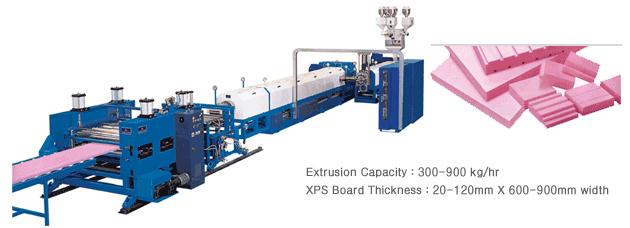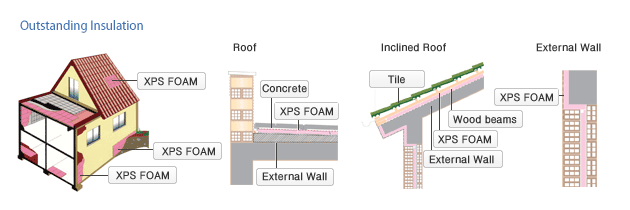(164) Start a XPS Foamed Board Extrusion Line
Expanded polystyrene foam (EPS) is the cheapest and least used foam board product on the market. This product typically has an R value of 3.6 to 4.0 per inch of thickness. Expanded polystyrene insulation is similar to the foam used for packing “peanuts” and it’s typically used for insulated concrete forms also knows as ICF’s. It is also sometimes used on commercial buildings for roof and wall panel insulation which is typically sandwiched between light gauge metal.
Cost = Cheapest of the foam insulation boards.
Extruded polystyrene foam (XPS) also known as blue board or pink board comes in many different thicknesses and edge profiles. This insulation board is probably one of the most widely used foam board insulation products in the residential construction industry. XPS has an R value of 4.5 to 5.0 per inch of thickness.
This is the product that I typically use to insulate basement walls. It’s reasonably priced, light weight and easy to use. This product is also used to insulate the outside of foundation walls and even under slabs.
Cost = This product is the middle of the road for these types of foam board insulation products.
Cost = Polyiso is the most expensive of the foam board insulation products however it’s the highest R value.
Polyurethane and polyisocyanurate are both closed-cell foams. They contain low-conductivity gases in the cells (usually one of the HCFC or CFC gases.) The higher R-Values (R 7.0 to 8.0) are the result of thermal resistance of the gases in the cells. This can lead to a couple of disadvantages including: off gassing of HCFC or CFC gases, and reduced R Value over time as the gas escapes.
 What is XPS foam board insulation? How is XPS foam board insulation used in my home? What is the R-value of XPS foam board?
What is XPS foam board insulation? How is XPS foam board insulation used in my home? What is the R-value of XPS foam board?
Why is there a coffee cup here and did you really install 4″ of XPS board in your attic when it was 95 F outside (yes!, and probably 115 inside).
XPS foam board is an insulation material similar to polyisocyanurate in its texture and rigidity. It is usually blue or pink in color, with a smooth plastic surface. Like fiberglass, the pink and blue colors are not natural but part of the manufacturing company’s marketing efforts.
Polystyrene is liquified to create XPS. This liquid is mixed into a foam then shaped in a flat mold. Once hardened, it is cut into the 4’x 8’ sheet boards that most customers have seen at Lowe’s as they walk past it to buy fiberglass.
XPS panels can come unfaced or faced typically with a foil air/vapor barrier. The R-value is about 5 per in. This type of rigid foam won’t absorb water and can act as an semi-impermeable vapor barrier. XPS is stronger and more durable than expanded polystyrene (aka Styrofoam) and it is comparably priced to polyiso.
Through several refinements of the process (and a tidy 80 years forward), the first production of long chain polymers were achieved by German chemist Hermann Staudinger based on the basic styrols. Shortly after German giant IG Farben began production of polystyrene for industrial and military use. This set the path for polystyrene in modern industry.
Finally, XPS is widely used in weatherization work in conjunction with caulking and foam guns (think Great Stuff). Weatherization crew use XPS to help air seal soffits, insulate sill plates and seal leaky attic spaces.Outside the insulation/auditing industry, XPS/Polystyrene is used for surf boards, manufacturing hobby models, creating architectural miniature models and of course Dunkin’ Donuts coffee cups.
Cost = Cheapest of the foam insulation boards.
Extruded Polystyrene Foam
This is the product that I typically use to insulate basement walls. It’s reasonably priced, light weight and easy to use. This product is also used to insulate the outside of foundation walls and even under slabs.
Cost = This product is the middle of the road for these types of foam board insulation products.
Polyisocyanurate and Polyurethane
Polyisocyanurate also known as polyiso is seen in all kinds of commercial building applications and more recently with residential building projects. Polyiso is typically used with a foil facing and it has an R value of 7.0 to 8.0 per inch of thickness. The reflective foil facing makes it an excellent insulation board when radiant heat is involved. The foil facing also makes it very easy to seal with good quality foil faced tapes.Cost = Polyiso is the most expensive of the foam board insulation products however it’s the highest R value.
Polyurethane and polyisocyanurate are both closed-cell foams. They contain low-conductivity gases in the cells (usually one of the HCFC or CFC gases.) The higher R-Values (R 7.0 to 8.0) are the result of thermal resistance of the gases in the cells. This can lead to a couple of disadvantages including: off gassing of HCFC or CFC gases, and reduced R Value over time as the gas escapes.
What is XPS Foam Insulation?
 What is XPS foam board insulation? How is XPS foam board insulation used in my home? What is the R-value of XPS foam board?
What is XPS foam board insulation? How is XPS foam board insulation used in my home? What is the R-value of XPS foam board?Why is there a coffee cup here and did you really install 4″ of XPS board in your attic when it was 95 F outside (yes!, and probably 115 inside).
Definition
XPS stands for Extruded Polystyrene. XPS foam board is essentially liquified then molded and compressed styrofoam. Ever grab your Dunkin’ Donuts coffee and not get burned? Well the hot coffee is kept from scalding your mitts by 1/4” of polystyrene foam. Imagine how well 2 or 4 inches would insulate (Answer: much better).XPS foam board is an insulation material similar to polyisocyanurate in its texture and rigidity. It is usually blue or pink in color, with a smooth plastic surface. Like fiberglass, the pink and blue colors are not natural but part of the manufacturing company’s marketing efforts.
Polystyrene is liquified to create XPS. This liquid is mixed into a foam then shaped in a flat mold. Once hardened, it is cut into the 4’x 8’ sheet boards that most customers have seen at Lowe’s as they walk past it to buy fiberglass.
XPS panels can come unfaced or faced typically with a foil air/vapor barrier. The R-value is about 5 per in. This type of rigid foam won’t absorb water and can act as an semi-impermeable vapor barrier. XPS is stronger and more durable than expanded polystyrene (aka Styrofoam) and it is comparably priced to polyiso.
History
The road to full Extruded Polystyrene started in the early 1800s. A German chemist, Eduard Simon, extracted an oily substance from sweetgum trees that he dubbed ‘styrol’.Through several refinements of the process (and a tidy 80 years forward), the first production of long chain polymers were achieved by German chemist Hermann Staudinger based on the basic styrols. Shortly after German giant IG Farben began production of polystyrene for industrial and military use. This set the path for polystyrene in modern industry.
Current Uses
Polystyrene has almost infinite applications in modern businesses. More narrowly, XPS foam board has value in many building and insulating applications, especially in harsh environments (like Maine!). XPS is suitable for cold storage, insulating below slabs and slab edges, insulating foundation or cellar walls and exterior sheathing as part of the building shell. It provides water resistant layers and its durability ensures good long term payback.Finally, XPS is widely used in weatherization work in conjunction with caulking and foam guns (think Great Stuff). Weatherization crew use XPS to help air seal soffits, insulate sill plates and seal leaky attic spaces.Outside the insulation/auditing industry, XPS/Polystyrene is used for surf boards, manufacturing hobby models, creating architectural miniature models and of course Dunkin’ Donuts coffee cups.
XPS Heat Insulation Foamed Plate Extrusion Line The system uses the PS as material and the vesicant to produce the XPS board, through extruding, pressing and draught. The whole system from the mixing to thermoform, and the assistant machine, only take 50x12m room..
And the XPS board has the uniform surface and full-closed beehive inner structure. So it has excellent heat preservation, heat insulation, sound insulation, damp proof, high anti-pressure. It can be free cutting also. So it be used widely in building roof, wall, ground, road, railwa
And the XPS board has the uniform surface and full-closed beehive inner structure. So it has excellent heat preservation, heat insulation, sound insulation, damp proof, high anti-pressure. It can be free cutting also. So it be used widely in building roof, wall, ground, road, railwa
| ||||||||||||||||||||||||||||||||||||||||
| ||||||||||||||||||||||||||||||||||||||||
 | ||||||||||||||||||||||||||||||||||||||||
| ||||||||||||||||||||||||||||||||||||||||
| ||||||||||||||||||||||||||||||||||||||||
 | ||||||||||||||||||||||||||||||||||||||||
XPS Machine Manufacturers | ||||
|


Thanks for sharing the post with us
ReplyDeletehow to stop water leakage
Liquid Gasket Sealant
gp silicone sealant price
wall leakage
Reliable PE Insulation Sheet suppliers in Gujarat are essential for seamless procurement. Verified PE Insulation Sheet suppliers in Gujarat offer high-quality insulation sheets suitable for industrial, residential, and commercial applications. They maintain consistent product standards and provide timely delivery, making it easier to meet project deadlines. By connecting with experienced suppliers in Ahmedabad and Gujarat, buyers can ensure durable, thermally efficient sheets, competitive pricing, and excellent support, allowing businesses to focus on quality and performance without worrying about supply interruptions.
ReplyDelete